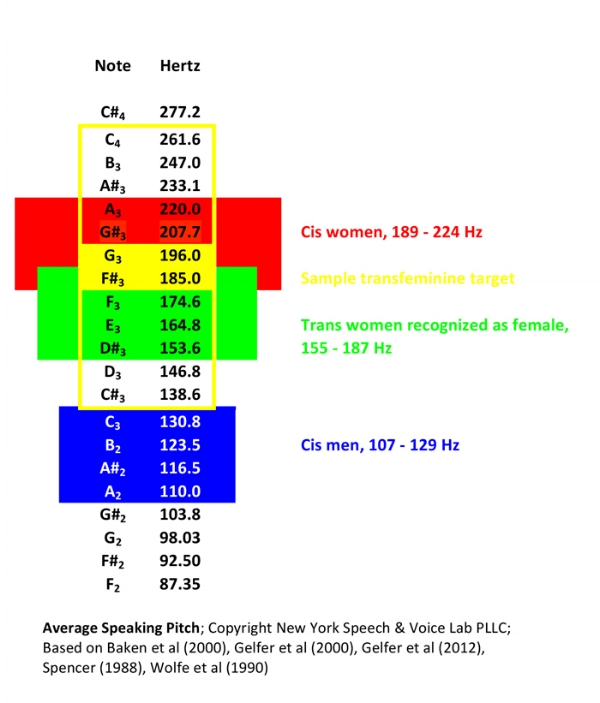Transfeminine speakers
There are many ways to be perceived as more feminine when talking, and you are likely familiar with one or more of them. People perceive speech as more feminine based on their personal experiences, social expectations, and social norms. And, of course, research has been conducted on women’s speech and feminine-perceived speech in different situations.
Below is a brief explanation of various basic features of feminine-perceived communication based on research and norms in Standard American English. They apply to some people some of the time based on how the average ear interprets them. They are not inherently female, and do not all apply to all women in all American contexts, or necessarily to your particular needs or in all situations you find yourself in. When they do apply to you, they may be shaped in various ways to optimize the feminine-perceived aspects of your own speaking style in context.
Pitch
While pitch is not the only feature used to achieve more feminine voice, it is often the most critical part. For most people, without a higher pitch, it is very difficult to be heard as feminine. Studies show that the average cisgender masculine speaking pitch is about an octave lower than cisgender feminine speaking pitch (see my interpretation per the chart). This chart also shows an example training target for an average feminine speaking pitch of 185 Hz (F#3) or 196 Hz (G3) (which may or may not apply to you). This target would allow natural pitch movement of about 12 semitones in conversation.
Intonation
A feminine-perceived voice can also have a wider pitch range. So, in addition to raising your average pitch, you can aim to be more expressive by moving your pitch around more, with higher highs. But don’t overdo it! Just bring out the meaning a little more than you normally do. This and other ways to shape your pitch movement are as follows:
Move your pitch around more, with higher highs
Move your pitch smoothly, like rolling hills rather than sharp peaks
Blend or connect each sound with the next sound
Slide into higher pitches to avoid voice breaks and hard voice onsets
End on a slightly higher pitch at the ends of sentences when the meaning allows it
Resonance
You may have heard that resonance can make the difference between being perceived as naturally feminine vs. sounding like a man with a high pitch. But what IS resonance? It is the reverberation of sound in a space. For humans, that space is in our chest, neck, and head. If you have a larger head and neck, your voice may sound bigger, darker, or boomy. An analogy is the difference in tone between a cello and a violin. Luckily, resonance is not solely affected by biology (size), it's how you behaviorally shape it in the upper airway. So, it's possible to sound more like a violin even though you have the body of a cello. To do so, you aim to utilize less of your vocal space by shifting the placement of your vocal energy and tongue, so that your voice sounds smaller, brighter, or less boomy. Try to aim your vocal energy forward, in the mask of your face, to reduce the reverberation of the voice in the back of the head. Subtle movements of the tongue can also restrict space in the mouth and throat. Resonance can be difficult to learn, but once you get it, it can make a big difference.
Vocal quality
Vocal quality can be an important component of a feminine-perceived voice. Some transfeminine individuals try to be breathy, giving their voice a soft, light quality. It is relatively easy to do. If that kind of sound suits you, be sure to not be too airy, which can sound unnatural or make it hard to be loud when you need to be or even cause vocal health problems.
Articulation
Feminine-perceived articulation is sometimes lighter than masculine-perceived articulation. Studies show that cis women hold their tongues in a more anterior position in the mouth. To achieve this, aim for more precise movement of the tongue and lips, and notice your tongue moving in the front of your mouth. Also try to widen your lips into more of a smiling position, which can help resonance.
Loudness level
Feminine-perceived speech can sometimes be quieter than masculine-perceived speech. Being a little quieter during conversational speech is fairly easy to do. Remembering to be quieter or choosing which situations are suitable for quieter talking is more of the challenge!
Spoken language
Stereotypical women’s language, relative to men’s, is commonly characterized as being more polite, being less direct, interrupting less, or elaborating more, among other things. In reality, language, more than voice, varies widely depending on the person, the situation, and other possible aspects of your identity, including your age, your relationship to your listener, your socioeconomic class, your ethnicity, the region you live in, the social context you are speaking in, etc. These factors will vary in importance depending on the situation. So, rather than uniformly using stereotypes, you should carefully consider your particular speaking situation in order to determine what kinds of words and how many words you should use, and what your conversation style should be. What is considered appropriate communication behavior in a particular situation? Is a typically feminine-perceived style important in that situation? What kind of communication style do you want generally, and how do you apply that depending on whether you are in a work meeting vs. with your best friend vs. with your dog?
Body language
How you sit, walk, and move is part of a more feminine-perceived image, including how you look when you are talking to someone. Some typical features that can be utilized are:
Fluid, continuous movements
Sitting posture is S-shaped
Leaning forward toward your speaker
Eye contact and expressive face
Non-speech vocalizations
Believe it or not, you can change how you laugh, cough, throat clear, and sneeze! A more feminine-perceived sound can be achieved by aiming for a higher pitch, a higher tongue, wider lips, and/or decreased loudness.
Singing
It is possible to modify your singing pitch range to a certain extent. I provide counseling regarding general expectations for singing in your case, utilize singing for speaking voice as necessary, and get you ready to see any of a number of singing teachers who experienced in working with transgender singers.
Voice counseling
In addition to teaching technical stills, I provide counseling regarding how you are feeling and thinking about your voice in the process of voice change. Sometimes mental obstacles are harder than the technical skills. I help you to address issues as they arise. Some may include staying mindful of your voice during daily interactions, accepting your best possible voice as part of your best feminine self, trying out new types of vocal behaviors even if they feel silly or strange at first, having the courage to use a modified voice in public or with certain people, coordinating your voice use with other changes in gender expression, or addressing how to manage new societal expectations or sexism when you are recognized as female in conversation. I help to navigate your thoughts and feelings to help you make the right steps for your voice at the right time for you.
Pitch-raising phonosurgery
Phonosurgery is becoming more available as an option to address pitch. Many many people choose voice training over phonosurgery for various reasons. One main reason is that voice training, when done well, is often sufficient. It is also comprehensive, since it can address all relevant and appropriate aspects of speaking, not just pitch, as well as strategizing voice use in real life. For even more comprehensive care, some people choose both - voice training as a primary intervention, and phonosurgery as an adjunct for consistency or even just peace of mind. Yet other people choose phonosurgery alone or as a primary intervention, with a limited number of voice therapy sessions to assist in phonosurgery aftercare. There is no one perfect way, as there are many factors that can come into play for each person, including voice skills, vocal function, voice goals, access to specialists, time commitment, finances, etc. If you are considering pitch-raising phonosurgery, I provide you with information regarding the benefits and limitations of different procedures, and I explain how it can apply to you and your goals and be integrated with other aspects of your voice and gender expression. I coordinate care with your surgeon, whether they are local or abroad, by providing counseling regarding expectations and voice rest, taking samples and images, tracking changes, and giving progress updates. In addition, I provide exercises to maximize results, which typically target pitch range, efficient vocal production, vocal stability, and vocal endurance, in addition to other aspects of voice that interact with pitch. Whether to do pitch-raising phonosurgery is a serious decision, since it is more risky than voice training, since it can sometimes result in reduced vocal function, and since most procedures are irreversible. I do my best to help you make an informed decision for yourself and help you through the whole process whatever you decide and with as much or as little voice training/therapy you choose.
Face Moves for FFS Recovery
Facial exercises following gender affirming facial surgeries aim to assist in the re-adaptation of the muscles, quicken recovery, and improve facial expressiveness. I have developed a program called Face Moves for this purpose to work with you, in coordination with your surgeon, on an individualized exercise plan during your recovery. For further information, check out a guest blog post I wrote for FACIALTEAM, which discusses the nature of the service.
Please refer to the gender affirming voice care page of this website for more information about my approach to voice training, and the voice samples page for some examples of voice changes achieved by some of my clients.
Quick tips
Hum your target pitch, such as G3 196 Hz, whenever you think of it, in order to adapt your ear and your voice to a higher speaking range.
Avoid yelling, screaming, or long periods of talking can be harmful to your voice, and can lead to tissue changes in the vocal folds.
Use a lighter vocal quality when alternating “ah” and “ha” many times slowly. Feel the airflow from the “h.” Then read aloud, listening carefully as you add in a little more airflow without being too breathy.
Think of someone who you feel has a nice, feminine conversation style in social situations. What do you like about it? Is it the words they choose? how much they talk? how much they listen? how much eye contact they have? How does your conversation style compare in that same kind of situation?
Consider filling out the Trans Woman Voice Questionnaire, which was designed to measure the voice experiences of transgender women who are presenting full-time. If this applies to you, it may help you understand how big of a factor your voice may be in your life and whether you should address any voice concerns you may have. (Translation of the questionnaire is permitted with the authors’ prior written permission and when WHO guidelines are followed.)

